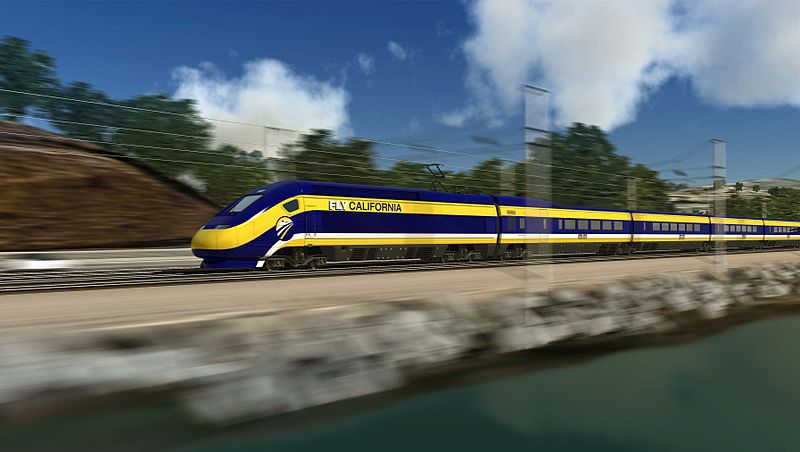A newspaper editorial dealing with the subject of California high-speed rail ran in the Dec. 24, 2019 Los Angeles Daily News edition. Access to the full Daily News editorial can be had here.
Discussed is the fifth and final phase or package of the construction program in the San Joaquin Valley or what is known as Construction Package 5 (CP 5).

The California High-Speed Rail Authority, it appears, is moving forward with plans to lay track in portions of the Valley between Wasco and Madera on 119 miles of right of way. What seems unusual is the condition under which $3.5 billion in federal monies for this particular part of the project are being awarded. Presumed is that the authority stands to lose the full funding allocation if the track infrastructure to be installed is not built in non-contiguous five-mile lengths. Understanding this to be the case, this leaves one to surmise that there has to be more to the story than just this.
At first blush, that dollars are being assigned or awarded in this manner, admittedly, sounds a bit odd.
However, without all of the blanks being filled in, there is hardly any way of knowing how far apart each of five-mile-long non-contiguous sections of track are going to be from each other and whether the gaps between sections at some future point in time (beyond the end of year 2022 presumably) are to be filled in. Here again, the presumption is they will be because, according to information in the latest California High-Speed Rail Authority-released Project Update Report, indications are that there is both money in hand and committed to construct not only from Wasco to Madera but extensions on each end to Bakersfield and Merced, respectively, covering a distance of 171 miles in all.
Making the case for high-speed-rail
In case no one’s noticed America is on a tear to advance transportation technology. Historically, it’s been this way since the early days when transportation first met automation. What’s different now is times have changed.
The issues today aren’t what they were a hundred years ago. New frontiers are being explored. Frontiers in aviation; frontiers in both outer space and in-the-sea exploration; and new horizons in air pollution, climate change and global warming mitigation – they’re all being investigated. A brave new world, indeed!
All of which call for solutions, one of those being development of high-speed train travel.
The evidence is there and clear that high-speed trains, even more so with a clean-energy supply, help clean air and, if not that, certainly cause no further air damage. They have the ability to move masses speedily and in various locations throughout the world, they do just that.
A case in point: Trains, in fact, are a big part of the Swiss way of life or living experience. And, nearly all of Switzerland’s railways run on renewable energy. All in a country where mountains are in more than abundant supply no less.
The fact of the matter is, in the town of Zermatt, cars are prohibited. There seems to be an overarching sentiment in that part of Europe to keep the environment there pristine. By all appearances, whatever efforts that have been and are being advanced to achieve that end, are working. Switzerland has to be one of the cleanest places on earth.
It is certainly not selfish to want at least a little of that heaven here in the United States. Desirousness, yes; selfishness, no. And, high-speed and other forms of rail travel as well as other types of non-fossil-fuel-powered modes can help bring that about. Japan has had high-speed rail for almost 60 years now.
Images: California High-Speed Rail Authority (upper); XpressWest (lower)

Ever heard of the term political terminology – ‘gross malfeasance’? Another proper term for this project is – ‘boondoggle.’
However, a quick review of the last 10-years equates to this factual statement “P**s Poor Planning equals P**s Poor Results!
That is what has been occurring in CA with their HSR project, and today they have zero funding to achieve a function operational quality HSR RR system, zero managerial HSR skill sets, incompetent, unqualified staff, and the biggie, zero transparency. More important ‘do-overs’ are the name of the game.
Finally, Construction Package 1 was bid at 980 million taxpayer dollars; however, per HSR’s own calculations, this section is over budget by 710 million taxpayer dollars. Without question, the creation of incompetent budgeting and controversial political issues!
I mentioned the Project Update Report in the post above. Laid out in this report are funding details for the Madera-to-Shafter section on pages 32 to 38.
What I can say at this point is the project is being built, progress is being made and indications are that, based on federal and state commitments, there is sufficient funding to fully fund the construction of the 119 miles between Shafter and Madera.
The information in the first sentence of your paragraph 4 above seems reasonable given what I already know.